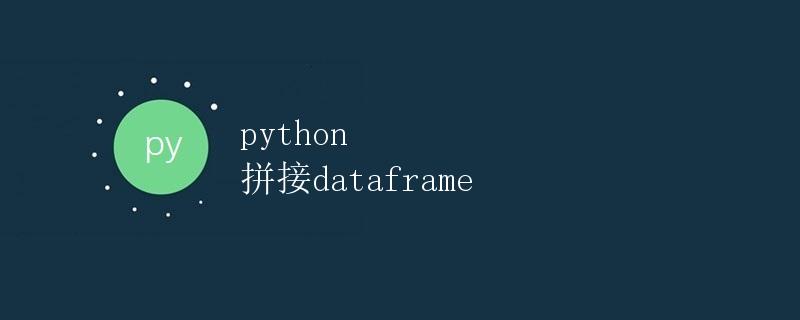Python 拼接DataFrame

在数据分析和处理中,拼接(concatenating)是一个非常常见的操作,特别是在处理多个数据表格或者数据集的时候。在Python中,pandas库提供了丰富的功能来处理数据,其中包括拼接不同的DataFrame。本文将详细介绍如何在Python中使用pandas库来拼接DataFrame,并给出多个实际示例来演示不同方式的拼接操作。
1. 使用concat()函数拼接DataFrame
pandas库中的concat()函数可以用来沿着指定轴(axis)将多个DataFrame拼接在一起。我们可以通过传递一个DataFrame列表给concat()函数来实现数据的合并。下面是一个简单的示例:
import pandas as pd
# 创建两个DataFrame
df1 = pd.DataFrame({'A': ['A0', 'A1'],
'B': ['B0', 'B1']},
index=[0, 1])
df2 = pd.DataFrame({'A': ['A2', 'A3'],
'B': ['B2', 'B3']},
index=[2, 3])
# 使用concat()函数拼接DataFrame
result = pd.concat([df1, df2])
print(result)
运行以上代码,得到的输出如下:
A B
0 A0 B0
1 A1 B1
2 A2 B2
3 A3 B3
在上面的示例中,我们创建了两个DataFrame df1 和 df2,然后使用concat()函数将它们沿着行方向拼接在一起。我们可以看到最后的结果中包含了df1和df2中的所有数据行。
2. 使用merge()函数拼接DataFrame
除了concat()函数以外,pandas库中的merge()函数也可以用来拼接DataFrame。merge()函数更适合处理具有相同键的数据合并。我们可以通过传递on参数指定合并的列名。下面是一个示例:
# 创建两个DataFrame
df1 = pd.DataFrame({'key': ['K0', 'K1', 'K2', 'K3'],
'A': ['A0', 'A1', 'A2', 'A3'],
'B': ['B0', 'B1', 'B2', 'B3']})
df2 = pd.DataFrame({'key': ['K0', 'K1', 'K2', 'K3'],
'C': ['C0', 'C1', 'C2', 'C3'],
'D': ['D0', 'D1', 'D2', 'D3']})
# 使用merge()函数拼接DataFrame
result = pd.merge(df1, df2, on='key')
print(result)
运行以上代码,得到的输出如下:
key A B C D
0 K0 A0 B0 C0 D0
1 K1 A1 B1 C1 D1
2 K2 A2 B2 C2 D2
3 K3 A3 B3 C3 D3
在上面的示例中,我们创建了两个DataFrame df1 和 df2,并且它们都包含一个键列key。然后我们使用merge()函数根据key列的值来合并两个DataFrame。
3. 使用append()函数拼接DataFrame
除了concat()和merge()函数,pandas库也提供了append()函数来拼接DataFrame。append()函数可以将一个DataFrame追加到另一个DataFrame的末尾。下面是一个示例:
# 创建两个DataFrame
df1 = pd.DataFrame({'A': ['A0', 'A1'],
'B': ['B0', 'B1']},
index=[0, 1])
df2 = pd.DataFrame({'A': ['A2', 'A3'],
'B': ['B2', 'B3']},
index=[2, 3])
# 使用append()函数拼接DataFrame
result = df1.append(df2)
print(result)
运行以上代码,得到的输出如下:
A B
0 A0 B0
1 A1 B1
2 A2 B2
3 A3 B3
在上面的示例中,我们创建了两个DataFrame df1 和 df2,然后使用append()函数将df2追加到df1的末尾。
4. 使用join()函数拼接DataFrame
除了上述几种方法,pandas库还提供了join()函数来拼接DataFrame,join()函数可以根据索引值来合并数据。下面是一个示例:
# 创建两个DataFrame
df1 = pd.DataFrame({'A': ['A0', 'A1'],
'B': ['B0', 'B1']},
index=['K0', 'K1'])
df2 = pd.DataFrame({'C': ['C0', 'C1'],
'D': ['D0', 'D1']},
index=['K0', 'K1'])
# 使用join()函数拼接DataFrame
result = df1.join(df2)
print(result)
运行以上代码,得到的输出如下:
A B C D
K0 A0 B0 C0 D0
K1 A1 B1 C1 D1
在上面的示例中,我们创建了两个DataFrame df1 和 df2,并且它们都包含一个索引列。然后我们使用join()函数根据索引值合并两个DataFrame。
5. 总结
本文介绍了在Python中使用pandas库来拼接DataFrame的几种方法,包括concat()、merge()、append()和join()函数。每种方法都有其适用的场景,根据实际情况选择最合适的方法来拼接DataFrame。
 极客教程
极客教程